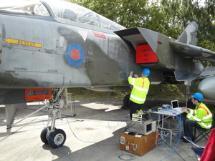Towards a Wireless Aircraft
As part of the BAE/EPRSC Flaviir UAV (unmanned aerial vehicle) project this is a sub project looking at the possible move towards a fly-by-wireless aircraft. There are many potential advantages in moving to a wireless aircraft. It could make an aircraft cheaper by reducing installation and maintenance costs, the reduction in weight would save on fuel, the expense of wiring and connectors and the dangers of the failing would be reduced and were there a problem there would potentially be more ways to route data around an aircraft. Other universities are looking at areas such as antennas, sensors and actuators on a small UAV but York's involvement is primarily with propagation modelling and network issues.
The inside of an aircraft is usually metallic with a number of electromagnetically coupled cavities including the wings, fuselage and the avionics bays within the fuselage. Such an environment is highly reverberant and with the other systems in there very noisy and so presents a difficult propagation environment. Modelling and understanding this is the key part of the project. In order to test performance the new ZigBee standard is being used which is similar to Bluetooth but specifically designed for wireless sensor networks.

Members
- David Hope
- John Dawson
- Andy Marvin
- Paul Mitchell
Partners
- BAE Systems
- Cranfield University
- University of Liverpool
- University of Manchester
- Nottingham University
Funding
- EPSRC GR/S71552/01 as part of the FLAVIIR programme
Links
- York Research Database (Publications, Related Projects, etc.)
Dates
- 2004-2009
Research
